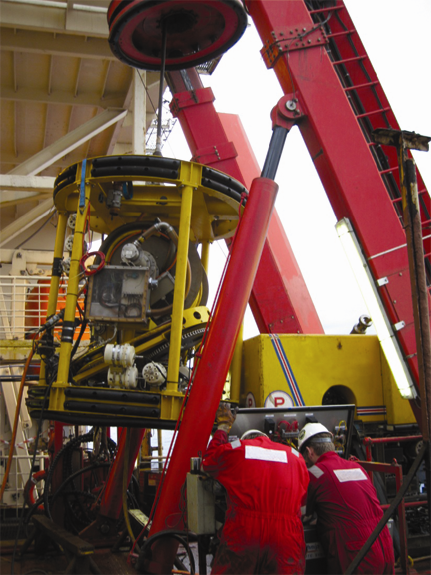Uncontrolled movement of A-frame
A member has reported an incident in which there was an uncontrolled movement of an A-frame mechanism. The uncontrolled movement of the A-frame luffing function occurred whilst personnel were working on top of the tether management system (TMS). The incident occurred during the re-attachment of a main lift umbilical bullet, following a mechanical re-termination. Winch and A-frame functions had been used to manoeuvre the end of the umbilical through the top of the TMS until the bullet reached the lift point swivel. A technician was on top of the TMS to guide the umbilical and then install the clevis pins and keeper plates. The technician was in full personal protective equipment (PPE) and also using a fall arrester fixed to the top of the A-frame.
It was at this point that the A-frame started to luff out. Because the winch did not pay out at the same time the umbilical came under tension and caused the TMS to lift approximately 1m off the deck. The technician standing by at the control console immediately hit the emergency stop, turning off the hydraulics to prevent any further movement. As soon as the TMS began to lift the technician on top managed to step off to safety on to the top of the winch frame. There were no injuries or damage to equipment.

Subsequent investigation by the company revealed that a proportional valve driver, a part of the hydraulic control system, had failed and was giving a constant output signal to the luffing valve without any input command. This caused the luffing valve to operate in an uncontrolled way, which in turn caused the A-frame to move. The valve driver was replaced and full normal operation was restored.
The following points were noted:
- The events could have resulted in a high potential incident, involving serious injury or damage both to personnel and equipment;
- The task should have had a specific risk assessment in place identifying the hazards associated with each job step;
- The availability of power to the A-frame at the point of attachment should have been identified;
- When the clevis pins were to be inserted, the hydraulics to the system should have been isolated thus avoiding any inadvertent operation.
The following actions were recommended:
- Operating procedures and risk assessments were changed so as to isolate the hydraulics whilst personnel are on top of the TMS with the bullet and lift point swivel mechanically connected;
- Modifications were made to the hydraulic control system to prevent a recurrence of this incident. The modification included the installation of a relay isolating the proportional valve driver output until the relative joystick is operated. This would prevent uncontrolled operation of the luffing rams if the proportional valve driver unit had a similar failure again.
Safety Event
Published: 10 July 2009
Download: IMCA SF 10/09
IMCA Safety Flashes
Submit a Report
IMCA Safety Flashes summarise key safety matters and incidents, allowing lessons to be more easily learnt for the benefit of all. The effectiveness of the IMCA Safety Flash system depends on Members sharing information and so avoiding repeat incidents. Please consider adding [email protected] to your internal distribution list for safety alerts or manually submitting information on incidents you consider may be relevant. All information is anonymised or sanitised, as appropriate.
IMCA’s store terms and conditions (https://www.imca-int.com/legal-notices/terms/) apply to all downloads from IMCA’s website, including this document.
IMCA makes every effort to ensure the accuracy and reliability of the data contained in the documents it publishes, but IMCA shall not be liable for any guidance and/or recommendation and/or statement herein contained. The information contained in this document does not fulfil or replace any individual’s or Member's legal, regulatory or other duties or obligations in respect of their operations. Individuals and Members remain solely responsible for the safe, lawful and proper conduct of their operations.
